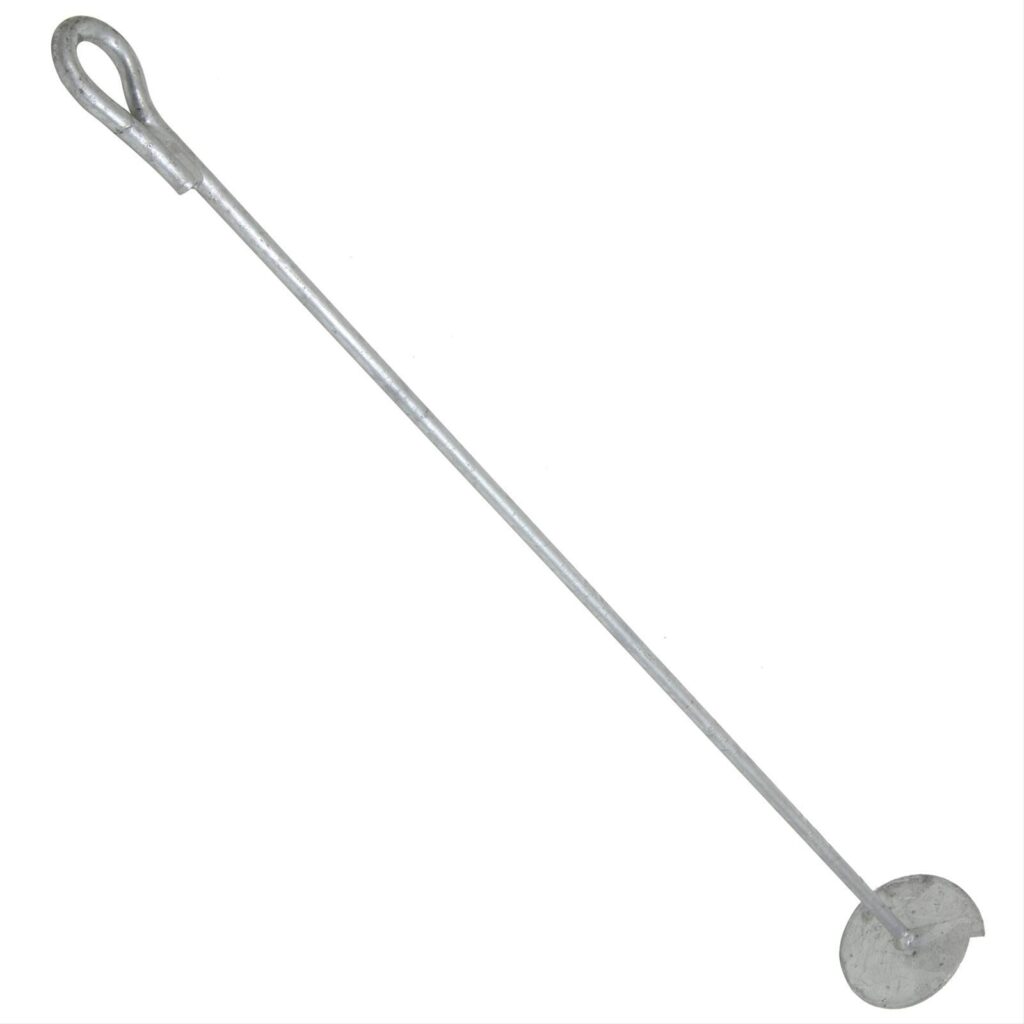
A guy anchor is a device used to provide additional support and stability to pole and supporting structures. A guy wire is also known as a guy wire anchor or a guy attachment. It mostly works in applications where the pole needs to resist the tension forces produced by conductors and winds. The guy anchor counteracts the lateral forces that can act on the pole and provide extra support. It helps prevent the poles from leaning, bending or breaking. The guy anchors provide support at specific locations such as corners, endpoints or areas with high loads. A guy anchor is from durable materials and corrosion resistant materials. These materials include steel, aluminum or galvanized steel.
Components of guy attachment

A guy anchor consists of several components that help provide support and stability to overhead power lines. They create a stable and reliable guy anchor system to provide support to the supporting structure. The available components of the guy anchors vary depending on the expected loads, soil conditions and specific installation requirements. The following are the main components of the guy wire anchor.
- Anchor rod – this is the part that embeds in the ground or foundation to provide a secure anchor point.
- Guy wire – this is a tensioned cable that connects the anchor to the pole to transfer the forces from the pole to the anchor.
- Thimble – this is a small device that creates a loop at the end of the guy wire to provide a secure attachment point for the guy wire to the anchor rod.
- Fasteners – fasteners include devices such as bolts, nuts and washers. They help secure the connections of strongest guy anchors for heavy loads.
Types of the guy anchor
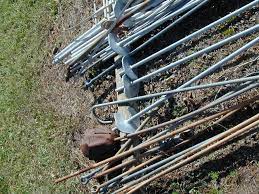
There are various designs of the guy anchors that allow them to work in various applications in the industry. Selection of a particular type of guy anchor depends on various factors. These factors include soil conditions, expected loads, installation requirements and local regulations. Additionally, it is advisable to consult with professionals in the industry for guidance on which type of guy attachment to use for your applications. The following are the common types of guy anchors.
Screw anchors – these are also known as helical anchors or earth screws. They screw into the ground to create a secure anchor point in areas with softer soils.
Concrete anchors – these are large concrete blocks buried horizontally into the ground to provide a wide contact area. They work in areas with challenging soil conditions and areas that require high load capacity.
Drive-in anchors – these anchors drive into the ground using impact or vibration methods. They are moslty used in areas with dense soil.
Rock anchors – these anchors work in areas with rocky or unstable soil conditions. They offer excellent resistance to tension forces in mountainous regions.
Ground anchors – these are anchors with long steel rods that directly embeds into the ground. They install at an angle to provide lateral support. They work in areas with sufficient soil strength and stability.
Application areas of durable guy anchor
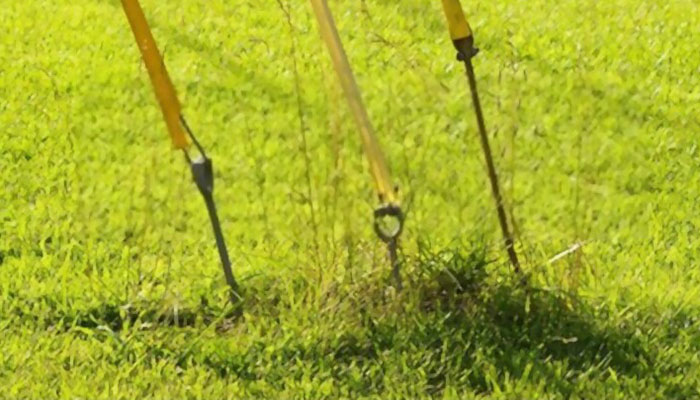
Durable guy anchors find uses in various applications that require stability and support. The specific use and requirements of the guy attachments vary depending on industry, type of structure and environmental conditions. The following are the main application areas of corrosion-resistant guy anchors.
- Electrical power distribution – guy anchors support utility poles carrying overhead power lines. They mostly work in areas with high wind loads.
- Wind energy – guy anchors help to stabilize wind turbines which is crucial for maintaining the desired alignment. They also prevent structural damage caused by winds.
- Constructions – the anchors provide support during the construction of buildings. They help prevent swaying or instability.
- Telecommunications – the anchors support tall antenna masts and communication poles to prevent excessive movement.
- Broadcasting – they also support transmission towers and antenna systems. They ensure stability and proper alignment of towers for efficient signal transmission.
- Sports lightning – stadiums lighting towers use guy anchors to provide support and stability. They also enable proper illumination of sports fields.
Guy anchor installation guide
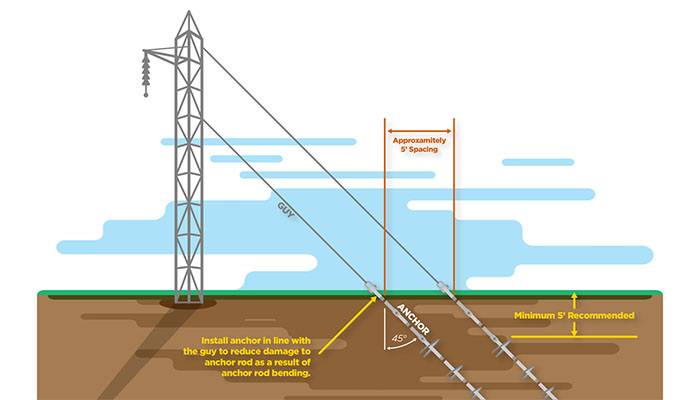
Guy anchors require proper placement and secure attachment which should come from professionals. The installation process varies depending on the anchor type, project requirement and local regulations. Additionally, it is advisable to consult with industry professionals for guidance and assistance during the installation process. Some manufactures provide installation manuals for the guy anchors. This should help in ensuring safe and reliable connections. The following is a basic installation guide of the guy attachment.
- Select a location for installation and clear the area of any debris. This debris may interfere with the installation. Consider soil conditions, load requirements and clearance from other structures.
- Create an appropriate foundation for the anchor based on the anchor type. Size of foundation will depend on the soil conditions and expected loads.
- Install the guy anchor in the prepared foundation using the suitable machinery and tools to secure it to the ground.
- Attach the guy wire to the anchor using guy wire grips or clamps to secure the connection.
- Apply tension to the guy wire to achieve the desired level of support and stability using tensioning devices.
- Fill the foundation around the anchor and ensure proper compaction of the backfill material to provide additional stability.
- Inspect the installed guy anchor system for proper alignment, tension and attachment. Make the necessary adjustments to ensure the guy wire is properly tensioned and aligned with the supporting structure.
- Keep records of the installation indicating location, date, anchor type and tension applied.
Selecting the best guy attachment
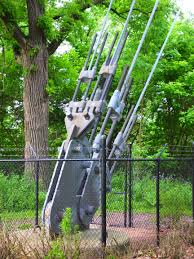
The best guy anchor is one that meets the specific requirements of your application. The selected guy attachment should ensure stability and reliability in overhead power line installation. You should also consider the soil conditions, load requirements and the desired tension of the applications. the following are the key factors to consider when selecting guy anchors.
- Consider the cost of the guy anchor system and balance the cost with the budget. Check the quality and performance before selecting the devices.
- Evaluate the available anchor types and their suitability for the specific application and check their advantages and disadvantages.
- Determine the expected loads to handle using the guy anchor by considering weight of the overhead lines supported. The selected anchor should meet these requirements.
- Ensure the selected guy anchor complies with local regulations, industry standards and codes to ensure safety, reliability and compliance.
- Assess the soil conditions at the installation site and consider the soil’s strength, stability and composition. This helps determine the most suitable anchor type and design.
- Consider the environmental conditions at the installation site by considering the temperature variations, moisture, corrosive substances or exposure to radiation.
Frequently asked questions
A guy anchor is a device used to provide additional support and stability to utility poles to resist tensional forces from wind loads. They help maintain reliability and stability of the power line infrastructure.
Guy wire anchors find uses in various applications in the industry that need additional support and stability. These applications include electrical power distribution systems, telecommunications, wind energy, broadcasting, sports lighting and construction. The selected guy anchor should meet the specific requirements of the application.
Guy anchors offer several benefits to the applications that require support and stability. These benefits make the guy anchors a valuable solution for supporting structures. The benefits include stability, safety, cost effective solutions, durability and flexibility in design.
Guy anchors have various limitations that affect the functionality of the installations. The limitations include complex installations, environmental limitations, soil conditions challenges, visual impacts, requires space and relies on guy wires. These are factors to consider when selecting the guy anchors for your applications.